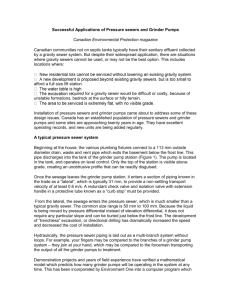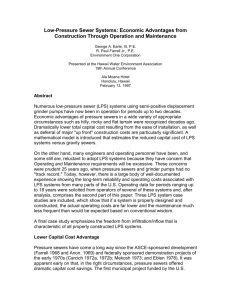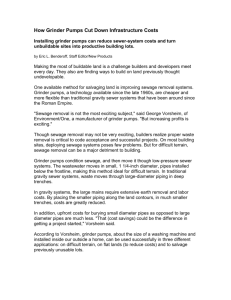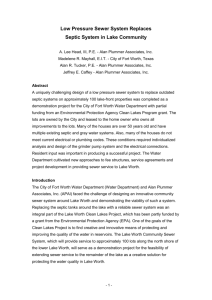Proven Alternative for Small Community Sewage Disposal Challenge
advertisement
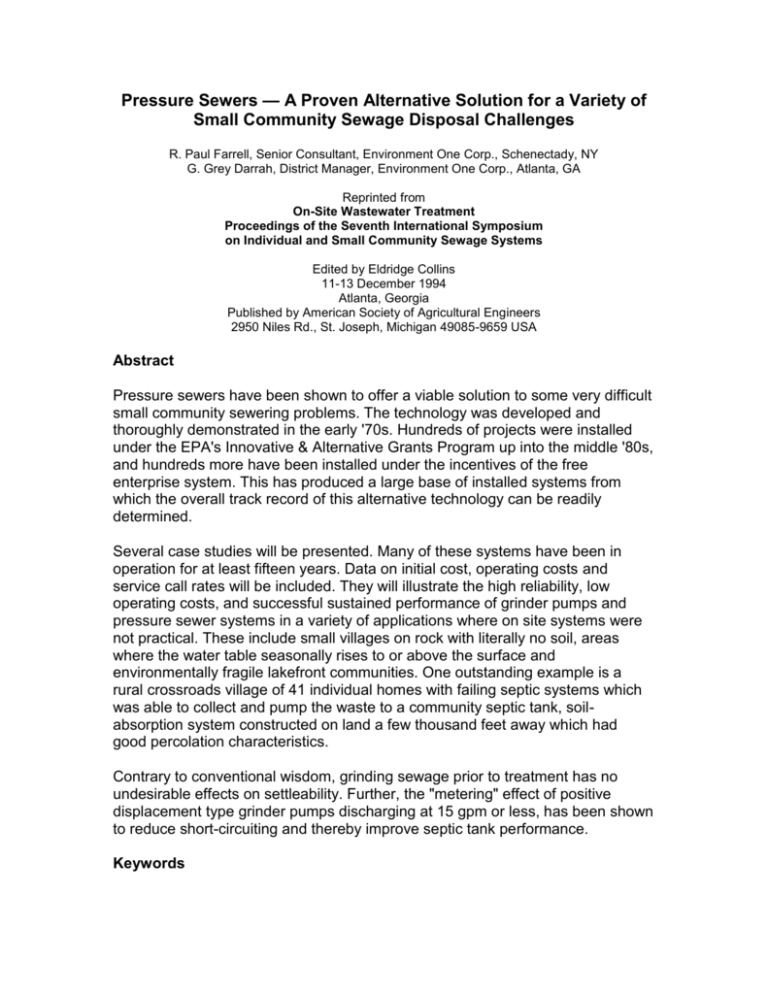
Pressure Sewers — A Proven Alternative Solution for a Variety of Small Community Sewage Disposal Challenges R. Paul Farrell, Senior Consultant, Environment One Corp., Schenectady, NY G. Grey Darrah, District Manager, Environment One Corp., Atlanta, GA Reprinted from On-Site Wastewater Treatment Proceedings of the Seventh International Symposium on Individual and Small Community Sewage Systems Edited by Eldridge Collins 11-13 December 1994 Atlanta, Georgia Published by American Society of Agricultural Engineers 2950 Niles Rd., St. Joseph, Michigan 49085-9659 USA Abstract Pressure sewers have been shown to offer a viable solution to some very difficult small community sewering problems. The technology was developed and thoroughly demonstrated in the early '70s. Hundreds of projects were installed under the EPA's Innovative & Alternative Grants Program up into the middle '80s, and hundreds more have been installed under the incentives of the free enterprise system. This has produced a large base of installed systems from which the overall track record of this alternative technology can be readily determined. Several case studies will be presented. Many of these systems have been in operation for at least fifteen years. Data on initial cost, operating costs and service call rates will be included. They will illustrate the high reliability, low operating costs, and successful sustained performance of grinder pumps and pressure sewer systems in a variety of applications where on site systems were not practical. These include small villages on rock with literally no soil, areas where the water table seasonally rises to or above the surface and environmentally fragile lakefront communities. One outstanding example is a rural crossroads village of 41 individual homes with failing septic systems which was able to collect and pump the waste to a community septic tank, soilabsorption system constructed on land a few thousand feet away which had good percolation characteristics. Contrary to conventional wisdom, grinding sewage prior to treatment has no undesirable effects on settleability. Further, the "metering" effect of positive displacement type grinder pumps discharging at 15 gpm or less, has been shown to reduce short-circuiting and thereby improve septic tank performance. Keywords Sewers, septic tanks, pressure sewers, reliability, economic effectiveness Introduction In the late '60s, the senior author was fortunate to have become deeply involved in the development of grinder pumps and the low-pressure sewers (LPS) which they make possible. The idea for pressure sewers was the brainchild of Dr. Gordon M. Fair, then professor emeritus of Sanitary Engineering at Harvard. His vision and the clarity of his thought process is obvious from his United States patent for "a sewer within a sewer" (Fair, 1968). It was his hope that this invention, which he dedicated to the public, would offer a solution to the problem of Combined Sewer Overflows. The development of early prototype grinder pumps was done under sponsorship of ASCE and the Federal Water Pollution Control Administration. Twenty-two years ago, a thirteen-month-long, highly successful, field demonstration of pressure sewers (sponsored by the New York Department of Environmental Conservation, with funding from the Federal Water Pollution Control Administration) had just been completed (Carcich et al., 1972). The number of commercial units in operation by then numbered a few dozen at most. In a paper before the New England Water Pollution Control Association, at about the same time, (Farrell, 1971) the senior author expressed his belief that low pressure sewers were a viable concept which had been carefully developed, thoroughly demonstrated and were about to become a commercial reality. In 1970 the first commercial grinder pump was installed at a marina in the Adirondacks. From that modest beginning, the cumulative number of grinder pumps produced by the author's company grew, slowly at first and more rapidly in recent years, so that today more than sixty-five thousand have been shipped. Meanwhile, several pump companies in the United States, Europe and Japan joined in, offering their variations on the basic theme. Today projects using hundreds of pumps are commonplace, and systems with a thousand or more connections are no longer unusual. Treatment of Wastewater From LPS Collection System Pressure sewers are primarily a transport system and accomplish little in the way of treatment. A question appropriately asked by many considering this technology is, "How will this pressure-collected wastewater affect the treatment works?" Grinder pumps have been successfully used to pump raw sewage to most types of approved disposal or treatment, including: individual household septic tank systems community septic tank-soil absorption systems holding tanks pumping station wetwells gravity manholes force mains aerated lagoons RBCs trickling filter plants constructed wetlands Pressure collected wastewater differs from that delivered by a conventional gravity system in two principal ways; namely: 1. gross solids have been ground in the pumping station to a particle size which generally is in the range of 6 to 13 mm (1/4 to 1/2") maximum dimension and 2. due to the watertight joints and absence of manholes in a pressure tight system, there is the potential for virtually eliminating extraneous flows, (infiltration/inflow). This was dramatically illustrated in Washington County, Maryland recently; where a 100 percent pressure collection system using grinder pumps went on line in 1991. Careful records have been kept of water usage, rainfall events and wastewater flows at the headworks of a modern activated sludge treatment plant. The Executive Director of the Sanitary District reported (Palmer, 1993) that wastewater flow ranged from 110 to 130 GPD per house and there was no measurable increase during or following major rainfall events. Many LPS networks discharge into larger systems where the affect is not measurable due to dilution. A smaller number either pump into a dedicated treatment facility or represent a significant fraction of the total flow arriving at the plant. Daily per capita flows measured at the Albany Demonstration for 13 months averaged only 34 gallons (Carcich et al., 1972). This same project showed that grinding had no deleterious affect on settleability as compared to wastewater transported by conventional gravity. Data from two EPA sponsored Pressure Sewer Demonstration projects, one STEP and one Grinder Pump, (Eblen and Clark, 1978 and Carcich et al., 1972) showed no significant difference in grease concentrations. Sections from pressure sewer pipelines, excavated after several years of service, showed no tendencies toward significant buildups in the pipe. Use of Grinder Pumps on Septic Tank Systems Pumping raw sewage into septic tank for treatment is best practice because: 1. 2. 3. 4. materials of construction are not exposed to anaerobic conditions settleability of ground raw sewage is not adversely affected particle size confined to nothing larger than 13 mm (1/2") permits use of remote site e.g., across a stream, or over hill and dale to any location suitable for soil absorption system Pumping septic tank effluent is not recommended because: 1. gases and/or their end products are corrosive to materials of construction 2. odor problems are likely 3. methane and hydrogen sulfide are threatening to personnel, and may pose an explosion hazard 4. if this is attempted with non-grinder pumps, they will clog or jam at an objectionable frequency. Contrary to conventional wisdom, solids do, on occasion, pass through septic tanks (example, cigarette filters). Basic research and field studies by the U.S. Public Health Service (Weibel et al., 1949-54) showed that flows of long duration, even if at low rates, caused "short circuiting" and corresponding solids carry out in single compartment septic tanks. The batch-wise operation of a grinder pump can serve to break up this pattern of continuous flow thus contributing to optimum solids removal efficiency. The interrupted flow pattern of a grinder pump and the continuous flow from a shower are illustrated in Fig. 1. Operating and Maintenance Experience From its inception, engineers had little difficulty accepting the idea that a pressure collection system would work, and that, under the right circumstances, it could offer dramatic savings in capital cost. Most early reservations were based on uncertainty about the long-term reliability and operating cost of a technology which, in 1971, had literally no "track record". Let's see how our knowledge has increased since then. From the beginning, data has been accumulated from which to calculate the Mean Time Between Service Calls (MTBSC). This number is an accurate measure of the overall service call rate on a group of pumps and is very useful for staffing and cost estimating purposes. It is calculated as follows: P = # pumps in service T = years in service S = total # of service calls in T years MTBSC (yrs) = (P*T)/S EXAMPLE — from Bloomingdale, GA System contains 998 pumps: P = 998 pumps Data is for a 6-year period, 1986-92: T = 6 yrs During this time there were 576 service calls: S = 576 calls MTBSC = (998*6)/576 = 10.4 years The prototypes in the 1972 Albany Demonstration Project had a MTBSC of 0.9 yrs. These data show that a tenfold improvement in reliability has taken place since that time. Table A has per pump O&M Costs and other data from several projects. Keys to a Successful Pressure Sewer Project The most serious concerns of those contemplating a low-pressure sewer system are reliability and long term operating costs. These factors have exhibited very wide variation from project to project during the 25 years since pressure sewers were successfully demonstrated. This is because all pressure sewers are not created equal. In examining this alternative it is wise to investigate in detail the subtle, but significant, differences in equipment and operating practices at various projects. A good decision will be based on more than a "generic" or conceptual basis alone. Over the years, engineers, owners and operators have discovered a few essential factors on which a successful system is invariably built. They include: Sound engineering plan and design Experienced firm with other jobs "under their belt" Proper hydraulic design — balance friction loss and velocity Include appurtenances for reliable convenient operation Consideration of special factors — cold climates, stream crossings, long retention times, slow initial build up, future growth, down hill runs, seasonal occupancies Knowledge to distinguish between essentials and frills — obtain all inherent cost benefits Community participation and support Real communication between "sewer committee," engineer and citizens Live demonstrations of equipment options Visits to neighboring systems — be guided by their experience Advance discussion of costs, financing options, and budget Equity in cost sharing by users Connect to house electric power — avoid separate power service to pump One pump per house — preferable to "sharing" a common unit LPS customers versus gravity etc. — same rate for all customers in district Reliable equipment Level control immune to grease — no float switches Constant flow over wide head range — avoid cavitation or shut off Proven electrical and fire safety — UL listed Non-clog grinding — low speed, high torque motor Minimize field erection — less field work = fewer mistakes & lowest cost Factory assembled and tested as complete unit Installation and Start Up Pre-bid conference with all contractors — knowledge yields lowest bid Training of winning contractor's personnel by factory reps On-site inspection by manufacturer's representative Start-up against check list under supervision of factory personnel Plan for service in advance Available on short notice when called for Stock of "exchangeable" spare units and basic parts Trained personnel — own force or contracted out Shop equipped with simple tools and test gages Homeowner education — usage practices and how to obtain service Case Histories Cuyler, New York The Hamlet of Cuyler is located in upstate New York, 40 miles southeast of Syracuse. With a population of 130 persons, Cuyler is literally a crossroads community. In the early seventies, the citizens became concerned about the public health and aesthetic consequences of numerous individual septic tank overflows, and even some surreptitious "straight pipes" into drainage ditches. The County Public Health Department was contacted and presented with the question, "What can be done, within our very limited resources, to solve this serious problem"? Thus was born an early "self help" project, though that name was not yet in general use. Piping system design consisted of a cross shaped layout with essentially one main branch and two tributary branches, serving the forty-one (41) single family houses in the village. Pipe was sized, in accordance with standards contained in the pump manufacturer's "Design Handbook," to minimize friction loss, while achieving velocities adequate to assure a selfcleansing system. In response to the hamlet's need for a "zero maintenance" treatment plant; a two-compartment, 10,000 gallon community septic tank, dosing siphon and soil absorption system was chosen. Land with a percolation rate suitable for this community septic tank system was found a few thousand feet away. An old abandoned railway track bed provided a right of way for the small diameter pressure pipeline. Actual capital cost was $166,000 compared to engineer's estimate of $574,000 for a conventional gravity system and treatment plant. The project went into full-time operation in 1978, and has performed without interruption and in excess of expectations since that time. Cuyler is too small to have a "Public Works Department"; so those repairs required from time to time are done by part-timers who are local residents; often by exchanging the pump core unit. Replacement parts and an occasional core rebuild are readily available from a nearby distributor or direct from the factory. A post construction evaluation of Cuyler's alternative approach, make by Roy F. Weston, Inc. for the EPA, (Westion 1983) indicated that the project was operating entirely up to expectations after the first five years. Specific conclusions included: 1. "...the benefit of lowest possible capital cost was achieved. 2. The community absorption field has been operating satisfactorily since 1978. 3. The benefit of minimizing operating costs and operational requirements, and maximizing system reliability has been achieved." Fairfield Glade, Tennessee Fairfield Glade is a privately developed second home and retirement community in the Cumberland mountains. A mix of gravity sewers, septic tanks and grinder pump pressure sewers serves the present population of 4,500 persons. It offers an excellent example of O&M costs because maintenance is performed in house by a dedicated crew and good records have been kept. Fairfield Glade has grown from 20 pumps in 1978 to 849 in January 1992. The average annual cost for O&M currently is running about $30 per pump and has shown a generally declining trend as shown in Fig. 2. (Gray, 1991). When this project was in the planning stage $40 to $50 per year was estimated for pump O&M. It is gratifying, fifteen years later, to have the owner tell us that our estimate was reliable and on the conservative side. Pierce County, Washington A pressure collection system in this very upscale community near Tacoma, Washington was started up in 1986 and presently consists of 900 progressing cavity (PC) and 46 centrifugal (CF) grinder pumps. All maintenance is done by county public utilities department employees and detailed records are available. Annual pump maintenance costs for the most recent four-year period averaged $51 for progressing cavity and $243 for centrifugal grinder pumps. The system supervisor attributes most of this difference to the need for regularly scheduled maintenance on the float switches associated with the centrifugals. The PC units, equipped with a static pressure sensing system, have no corresponding requirement. Equipment Review Grinder pumps are available from a number of reputable companies. Each manufacturer has executed a product design in his own particular way, and any brand on the market today has the generic features envisioned by Dr. Fair. The progressing cavity grinder pump has several unique and significant features which have contributed to its widespread use and dominant market position. Rather than discuss those details at this time, we suggest that you review the available equipment, its features and performance record, and make an informed choice. Conclusions 1. During the three decades since Gordon Fair's conceptual description of "a sewer within a sewer," grinder pumps and pressure sewers have: o o o Been custom developed and thoroughly demonstrated Become eligible for construction loans and grants Been accepted by responsible federal, state and local government agencies o Become an accepted alternative routinely considered by most engineering firms o Solved difficult technical and economic problems throughout the United States and Canada o Begun to spread rapidly around the globe 2. Capital cost savings are significant in the right situations including: shoreline properties, rocky areas, high water tables, low density housing, and a variety of sites sensitive to the environmental trauma typically necessitated by conventional gravity sewer construction. 3. There have been few serious operating problems with pumps, pressure lines or treatment works. The complete elimination of infiltration/inflow has been demonstrated in several locations served exclusively by pressure sewers. 4. Highly reliable equipment and systems are operating routinely all over the United States, Canada and Scandinavia. Operating and maintenance procedures and histories are available from a variety of installations with years of satisfactory experience. Those now considering pressure collection systems for the first time can benefit from the collective experience of many fellow system managers, operators and engineers. Pressure collection systems can be planned which will operate reliably into the foreseeable future, within budget, and with few surprises. References 1. Carcich, Italo G., Hetling, Leo J. and Farrell, R. Paul, (1972), "A Pressure Sewer System Demonstration," US EPA-R2-72-091 2. Eblen, Jessie E. and Clark, Lloyd K., (1978), "Pressure and Vacuum Sewer Demonstration Project Bend, Oregon," US EPA-600/2-78-166 3. Fair, G.M., (1968), "Converted Sewer System," United States Patent 3,366,339. Filed Nov. 26, 1965, and assigned by the inventor to the public 4. Farrell, R. Paul, Jr., (1972)"Pressure Sewers and the Grinder Pump Which Makes them Possible," Journal of the New England Water Pollution Control Association, vol. 6, no. 2 5. Gray Donald D., (1991), "TN Community's Grinder Pumps Provide Positive O&M Statistics"; in "Small Flows," published by Small Flows Clearing House, West Virginia University 6. Palmer, Lynn H. (1993), "Preserving the Antietam Battlefield at Affordable Cost," in Proceedings Collection Systems Operation and Maintenance, Water Environment Federation, Tucson, AZ 7. Weibel, S. R., Bendixen, T.W. and Coulter, J.B., (1949-1954),"Studies of Household Sewage Disposal Systems"— Parts I - III, U.S. Public Health Service, Cincinnati, OH 8. Weston, Roy F., Inc. (1983), "Interim Report, I/A Technology Assessment, PostConstruction Evaluation of Cuyler, New York Grinder Pump-Pressure Sewer and Community Soil Absorption System," EPA Contract 68-03-3055
